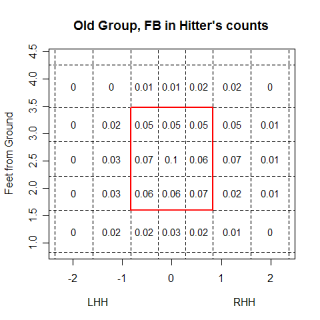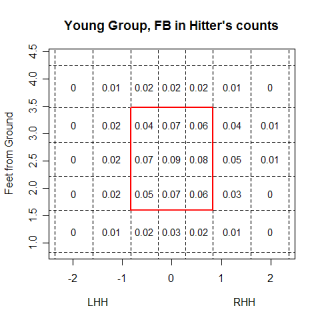
| Command Post | January 04, 2008 |
Tom Glavine has a reputation for consistently posting a better ERA than his peripheral statistics would otherwise suggest. Glavine's ability to change his approach based on the situation has been covered, and the basic idea is that he nibbles even more than normal in hitter's counts and is willing to allow some walks instead of giving in to hitters by throwing a meatball. Glavine's ability to leverage his walks is noticeable among all pitchers, but some other older pitchers have shown this "ability" as well. Is this nibbling an old-pitcher trait and are there other pitching patterns that old pitchers have compared to younger ones? How does the movement and speed on specific pitches compare across age groups? Where do different generations of pitchers locate their pitches? One year of data isn't going to give a great indication of how pitchers and their pitches age, but this is one step towards answering those questions. I created two groups of pitchers, old (34 years old and older), young (24 years old and younger), and looked at how each group pitched.
Glavine's willingness to sacrifice walks for a decrease in power provided the spark behind this article, so the first thing I wanted to see was if there was any difference in the location of pitches between the age-groups. Overall, there was very little difference between where the two groups located their pitches, but looking at specific situations some differences could be seen. Hitter's counts are times when nibbling would be especially advantageous, and when you compare the two groups of pitchers in hitter's counts, the differences become clearer. The images below are for extreme hitter's counts (3&0, 3&1 and 2&0) and only include fastballs. I included only fastballs because I wanted to see where pitches were located even when the pitcher "gave in" to the hitter's count and threw a fastball.
 nbsp;
nbsp;
The older pitchers have a higher percentage of fastballs in almost all of the border regions at the edges of the strike-zone. The differences aren't huge in any one area, which is probably more of a result of the fairly large regions used, but the older group appears to be throwing more at the margins. Not surprisingly, older pitchers fared a little worse when balls were put into play, which is one reason they are nibbling more than younger pitchers. Despite the older pitchers throwing fewer pitches in the strike-zone, batters swung at almost the same percentage of pitches from older pitchers as they did for younger pitchers and older pitchers didn't get any more called strikes than younger pitchers.
All FB-Hitter's Counts Group BABIP SLGBIP Swing% Called% Young 0.352 0.664 0.39 0.31 Old 0.372 0.682 0.38 0.31
Looking at all pitches in hitter's counts, it's unclear how much nibbling is going on or how effective it actually is. However, if you just look at pitches thrown within a 4 inch window, centered on the black of both sides of the plate, the picture changes. In these windows, which I think is where the nibbling largely takes place, old pitchers dominate their younger counterparts. Not only do they get a higher percentage of called strikes, but the slugging average on balls in play is almost .200 points lower.
FB within 4 inches of either corner-Hitter's counts Group BABIP SLGBIP Swing% Called% Old 0.263 0.421 0.35 0.37 Young 0.383 0.617 0.35 0.32
If you expand the chart above to cover all pitches in all counts, but still only look at that limited region, the old pitcher advantage almost completely disappears. Older pitchers still get more called strikes, which could be the older pitchers throwing more to the strike-zone as it is called, but the SLGBIP and BABIP values get much closer, with younger pitchers doing a little better overall.
All pitches within 4 inches of either corner-All counts Group BABIP SLGBIP Swing% Called% Old 0.313 0.445 0.47 0.24 Young 0.308 0.439 0.46 0.21
Without a larger sample, I don't think you can make any huge conclusions about the power of nibbling, but there are fundamental differences between the two groups of pitchers. Getting back to the extreme hitter's counts again, the pitchers in the young group threw 79% fastballs in those counts, which is a totally different approach than the pitchers in the older group, who only threw 63% fastballs in those counts. To put those values into some type of perspective, I previously found that in hitter's counts, the amount of fastballs thrown was very dependent on the quality of the hitter, with better hitters seeing fewer fastballs than bad hitters. Hitters with a SLG above .550 saw roughly 61% fastballs, while those with a SLG below .350 saw 74% fastballs. My older group was pitching to every hitter like they were facing Albert Pujols while the younger group was pitching to everyone like they were facing Willie Bloomquist. In pitcher's counts, both groups of pitchers threw roughly the same amount of fastballs, which is also what happened with different calibers of hitters as well. Both Pujols and Bloomquist saw the same amount of fastballs when they were in a pitcher's count.
The differences in how the groups pitched is at least partially due to differences in the repertoire of the groups. The table below shows the frequency that they threw each pitch, with the big difference being the amount of time they threw fastballs. This is in all counts, not just hitter's counts, but the older pitchers still are more cautious throwing their fastballs than the younger ones are.
Group FB% CH% CB% CT% SL% Old 0.50 0.17 0.08 0.07 0.18 Young 0.58 0.13 0.10 0.04 0.15
One reason for this could be the quality of the pitch. The table below shows the average values for fastballs for each group, (the pfx values are the average of the absolute values to put LHP and RHP on the same scale), and the average fastball for the older pitchers is slower, probably making it a little easier to hit. Another interesting tidbit from this table is that the older group has less vertical drop on their curveball.
Group FB-spd FB-pfx FB-pfz | CB-spd CB-pfx CB-pfz | CH-spd CH-pfx CH-pfz Old 89.9 6.43 9.02 | 75.3 5.13 -3.84 | 81.5 6.67 5.89 Young 92.1 5.57 9.43 | 77.0 5.63 -4.60 | 82.6 6.38 6.32
It would be interesting to see if there was a steady decrease in velocity or movement as a pitcher gets older, but the biggest problem with having just one year worth of data is that there is no good way to compare a player to himself at a younger age. Dividing them by age is a good start, but I'm really comparing two groups of pitchers, one group made up of players who have survived 10+ years in the major leagues (and possess certain traits that let them survive) and another group that is made up of some players with those traits (who will eventually make it into the old group) and some without those traits. When comparing the groups, I can't say that younger pitchers have certain traits, but rather that the younger group in my sample have certain traits.
This selection bias is going to be present in any study that looks at aging (only the players who do well will survive to be included in subsequent samples), but I think that the pitch f/x data is well suited to minimize the problem. If a certain number of pitches (say 100) is enough to establish how a pitch moves, the prior success needed for a pitcher to throw that many pitches in the future is much lower than the prior success needed to throw enough innings to show a realistic portrayal of skill as a pitcher ages. This won't eliminate the problem but in certain cases it could help minimize it.
Comments
Great work as usual.
I think you hit it at the end: pitch repertoire. You can even do something more basic: fastball speed. How about breaking up your young pitchers into two groups, based on fastball speed. Make it so that the mean of your "slow" young pitchers matches the mean of you old pitchers.
So, if the average fastball speed of your old pitchers is 88.2mph, and your young pitchers range from 86 to 96, then only select those with a fastball speed of 86 to 90 (such that the mean is 88.2), and put them in the slow-young group.
If you can in addition do the "% of pitches that are fastballs", to match the old guys, that'd be good too.
Anything to control for everything, except age.
Posted by: tangotiger at January 6, 2008 4:28 AM
I'm with Tango. It's about pitch type and selection.
Try taking a look at Glavine's fastball and changeup% in all counts, they should be around the same.
Then try doing the same to pitchers who had sensible BABIP "luck" this season, such as Rogers, Timlin or Litsch. They all throw non-fastballs most of the time. Rogers throws changeup, Timlin and Litsch are sliderballers. There is a pattern there. After all, fastballs have the worst BABIP, so it is logical that unless you have Saito or Papelbon's fastball you should throw it less than your best pitch. But how many pitchers do that?
Posted by: RS at January 8, 2008 1:25 PM